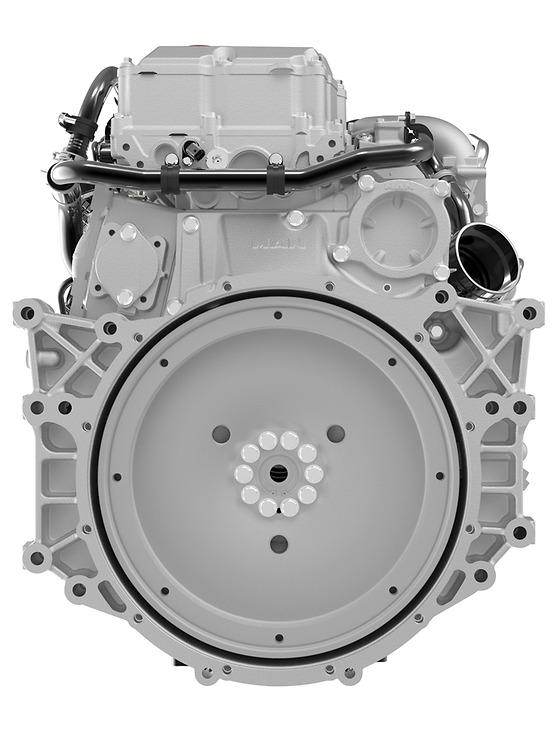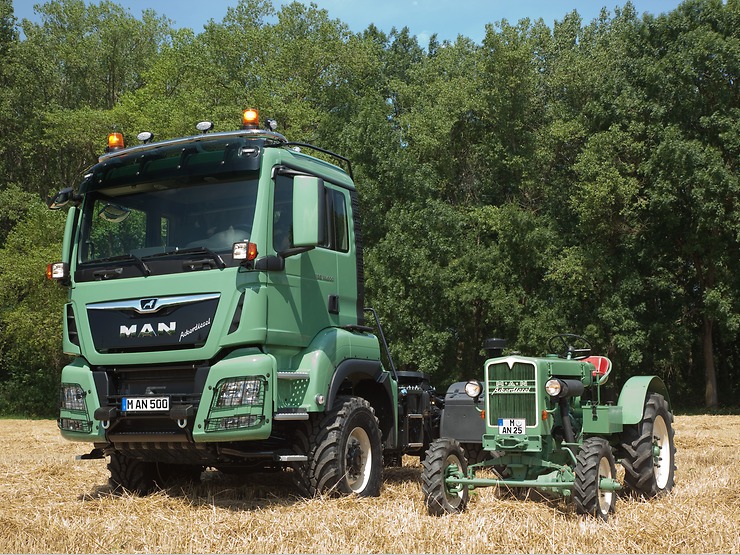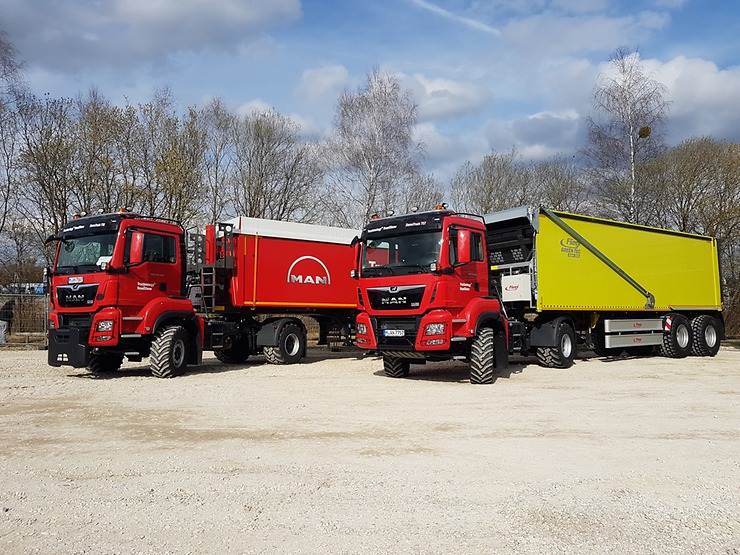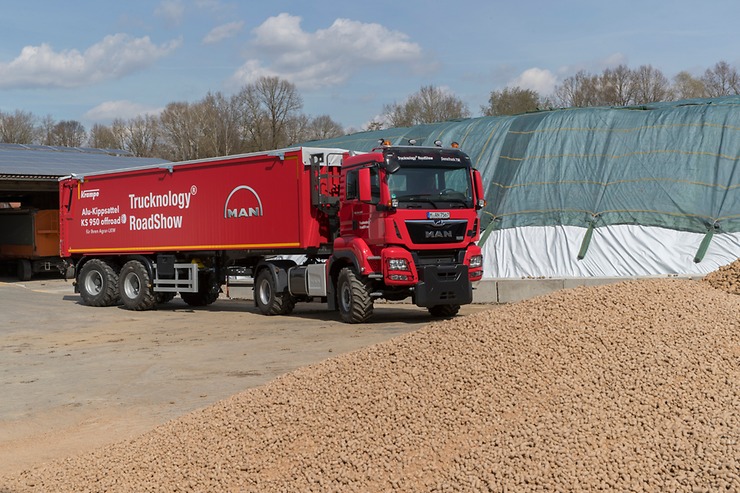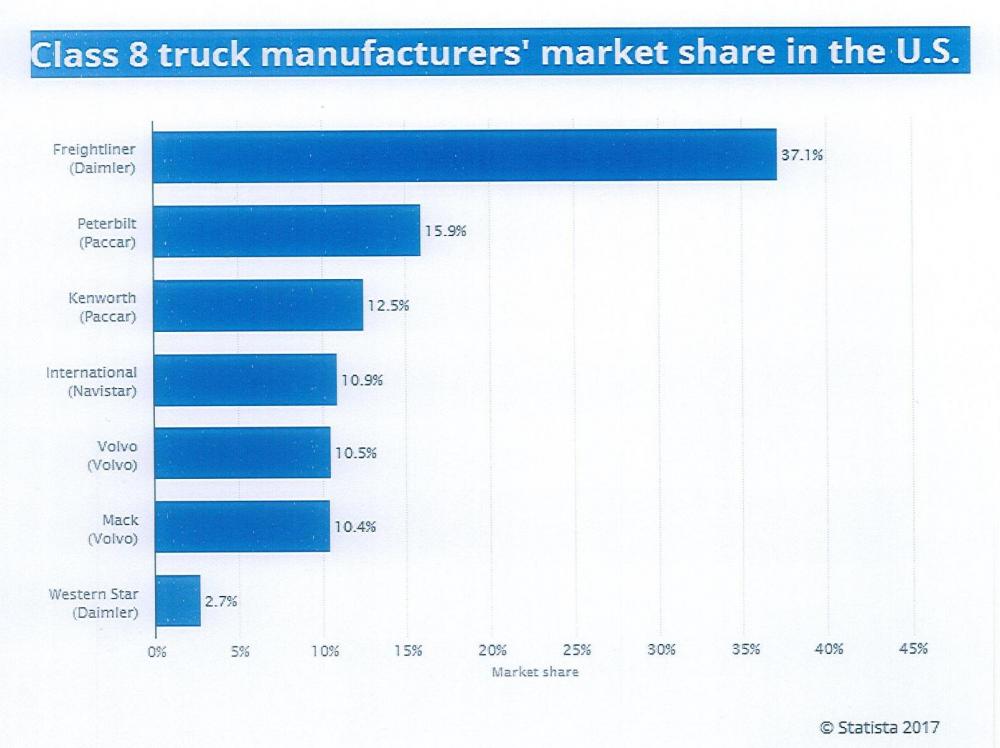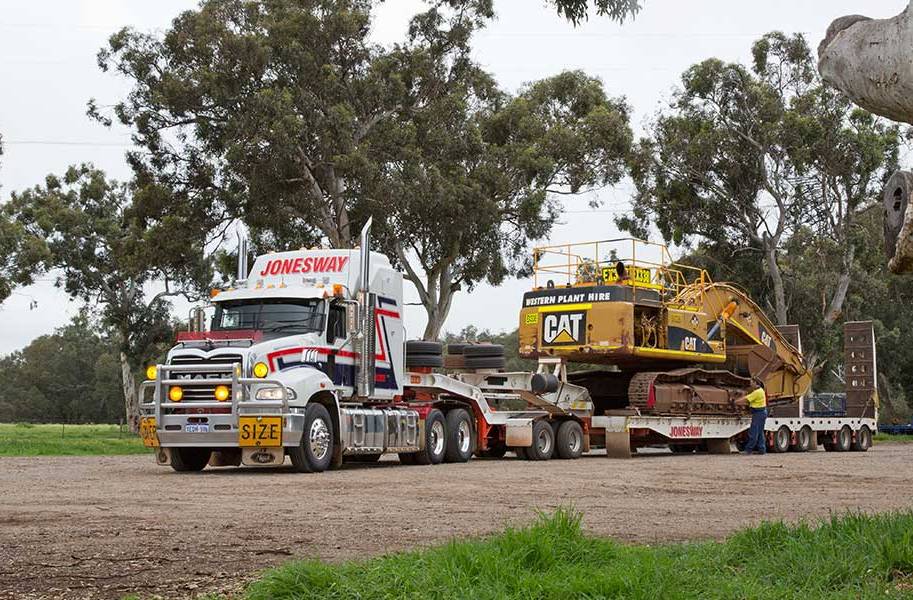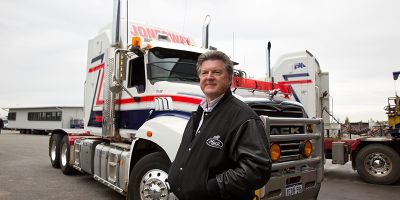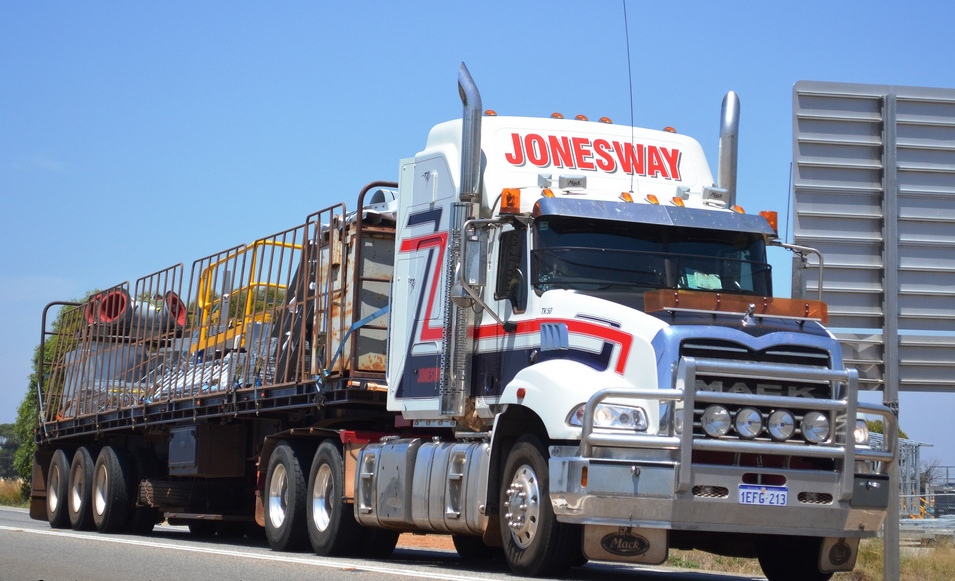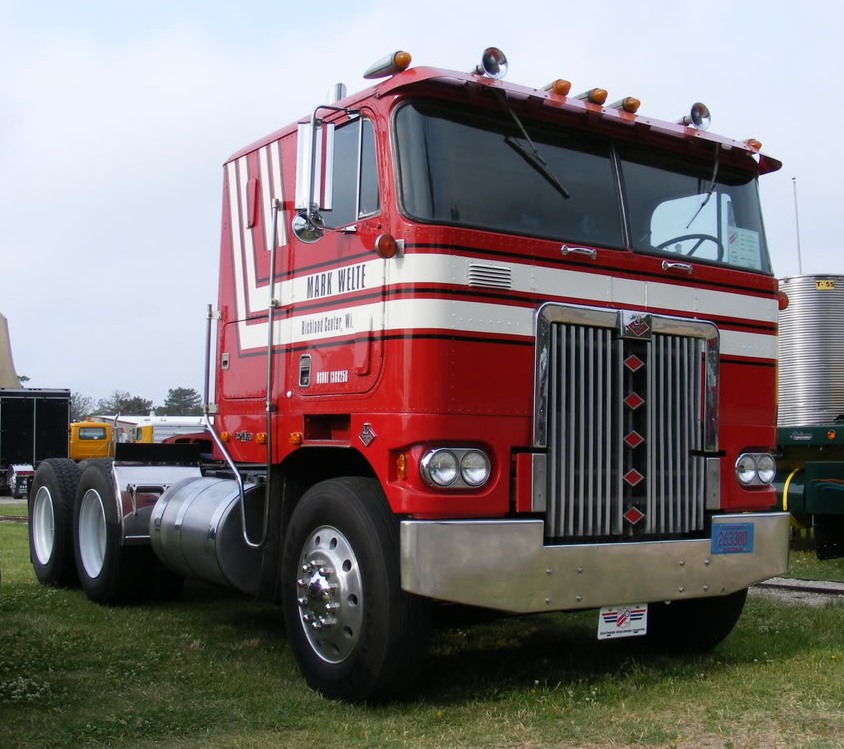
kscarbel2
Moderator-
Posts
18,905 -
Joined
-
Days Won
114
Content Type
Profiles
Forums
Gallery
Events
Blogs
BMT Wiki
Collections
Store
Everything posted by kscarbel2
-
Goodyear G367 drive tires. Years ago, there was no better combination than Bridgestone R290 steer tires and Goodyear G367 drive tires.
-
Agritechnica: MAN Engines Presenting Global Innovations for Agricultural Machinery and Cogeneration MAN Truck & Bus Press Release / August 4, 2017 Newly developed 9 litre class diesel engine for tractors and harvesters; new gas engine based on E32 bridges performance gap in cogeneration engines At Agritechnica 2017 – the largest agricultural equipment trade fair in the world hosted in Hanover, Germany – MAN Engines will be presenting a diesel engine with nine-litre displacement to the international public for the first time. From the outset, the straight-six engine was designed and constructed as a completely new conception, especially for off-road uses. This allows the latest unit in MAN Engines’ portfolio to close a gap in performance between the existing D08 and D26 engine series. Conventional applications for the 9 litre unit are agricultural, such as in tractors or harvesters. For the first time, MAN Engines is also exhibiting an E32 series-based gas engine with 450 kWmech. The twelve-cylinder gas engine achieves this performance level in 50 Hz operation at 1,500 rpm, as well as in the 60 Hz variant at 1,800 rpm. The E3262 LE2x2 is designed for operation with biogas or special gases. The possible applications also include the very wide field of cogeneration for the industrial, commercial, municipal and leisure sectors. This also sees MAN Engines bridge a gap in the existing range of gas engines. At the same time, customers will receive a modern unit with improved efficiency levels. Both new products can be viewed at Agritechnica between 12 and 18 November at the exhibition centre in Hanover at the MAN Truck & Bus booth (C45 in Hall 16). .
-
MAN Truck & Bus Press Release / August 4, 2017 A variety of transport tasks are arising in agricultural business and for contracted hauliers. Thanks to their high payload at a gross train weight of 40 or 38 tonnes, low fuel consumption and typical high driving speed of 89 km/h, trucks are gaining ground in the transport chain between farm, field and warehouse. At this year's AGRITECHNICA trade fair, taking place from 12 to 18 November in Hannover, MAN will be presenting an agricultural truck, based on a MAN TGS semitrailer tractor, alongside the engines for installations developed by MAN Engines, at Stand C45 in Hall 16. The 500 hp all-wheel drive tractor unit will win over potential customers with its industry-tailored configuration: approval for use as an agricultural or forestry tractor unit, load-sensing hydraulic system on the PTO on the flywheel side, various trailer couplings and wide, soil-friendly agricultural tyres (445/65R22.5 at the front and 600/50R22.5 at the rear). The advantage of the MAN agricultural semitrailer tractor concept lies in the combined street and field use as well as the fact that it can be used all year round. Once farming operations and harvest time have come to an end, you need only exchange the semitrailer and the tyres to be able to use this MAN truck for construction transportation and as a snow-plough vehicle during the winter. Reminiscing about days gone by: tractor production ended at MAN in 1963. The MAN TGS 18500 4x4 BL trade fair exhibit bears the original MAN green (MAN-GRUEN - M107) paint and light ivory-coloured rims that were typical of MAN tractors. .
-
Scania Group Press Release / August 4, 2017 Scania set an unofficial world record at the recent Convoy in the Park truck festival at the Donington Park race circuit in England. An amazing 421 Scania trucks gathered in and around the Scania Village area of the circuit, making it the largest gathering of a single make of truck in one place. The huge array of trucks made for an impressive sight, and ranged from vintage-era 110s through 140s to the New Truck Generation. The prize for Best Scania truck in the village went to the V8 customised T-cab driven by Coles & Sons, and this truck also won the overall prize for best in show. The record was just one of the activities Scania Great Britain had organised for the weekend. There was a Scania Driver Competition, face painting for the kids, caricaturists on hand to draw adults and kids and two very special Scania trucks that had been customised by Svempa – the Red Pearl and the Chimera. Oh, and we shouldn’t forget the very popular Scania rubber ducks (a nod to the 70s film Convoy) that were given to those who tweeted a photo of themselves beside a Scania truck. The event was a great success, and yet more proof of truck enthusiasts’ enduring interest in all things Scania. .
-
- 1
-

-
-
We've changed the designation system quite a bit. This PDF link shows what BC is speaking of..............https://www.google.com/url?sa=t&rct=j&q=&esrc=s&source=web&cd=1&ved=0ahUKEwjpzdTGnv_RAhUF04MKHfsxD54QFggaMAA&url=https%3A%2F%2Ftil.scania.com%2Fidcplg%3FIdcService%3DGET_FILE%26dID%3D229035%26dDocName%3DDIS_0000087_18%26allowInterrupt%3D1&usg=AFQjCNEczAahURKW-znx_i8BeD1BSe_3Ew&bvm=bv.146496531,bs.2,d.eWE&cad=rjt
-
Volkswagen Group launches trade-in incentive for Euro 1 - Euro 4 diesels; pan-European software update for Euro 5 and some Euro 6 diesels Green car Congress / August 5, 2017 Embracing the outcome of the German National Diesel Forum earlier this week (earlier post), the Volkswagen Group announced that it will offer a trade-in incentive for Euro 1 - Euro 4 diesel models which will apply across all brands in the Group. In addition, the software update for Euro 5 and some Euro 6 diesel vehicles will be available throughout Europe and not just in Germany. The incentive is currently being prepared by the Group’s Volkswagen Passenger Cars, Audi, SEAT, ŠKODA, Porsche and Volkswagen Commercial vehicles brands and will be on offer soon. With the incentive to trade in their vehicles we are giving our customers strong motivation to switch to a modern, more environmentally compatible vehicle powered by an internal combustion engine or an alternative drivetrain technology. This incentive can be implemented quickly and will have a swift, quantifiable and sustained effect on significantly reducing NOx emissions and significantly improving air quality. —Matthias Müller, Volkswagen AG CEO In Germany, the Volkswagen Group will install a software update on approximately four million Euro 5 and some Euro 6 diesel vehicles in total as agreed in order to reduce NOx emission levels. This figure also includes the approximately 2.5 million vehicles already being recalled, of which more than 70% have already been refitted. In addition, the Volkswagen Group will be offering the software update to its diesel customers throughout Europe. As a result, NOx emissions from Euro 5 and some Euro 6 diesel vehicles currently on the market can be reduced by an average 25 to 30%. Furthermore, the Volkswagen Group will contribute to the €500 million “sustainable mobility fund for cities”. The auto industry and the Federal government will each contribute €250 million. The Volkswagen Group’s contribution to the fund will be proportionate to its market share in Germany and will therefore represent a substantial amount.
-
German party hit by ‘dieselgate’ whitewash The Financial Times / Regional SPD leader checked with VW before speech on emissions scandal Germany’s main centre-left party has suffered a political setback ahead of next month’s challenge to Chancellor Angela Merkel in parliamentary elections after one of its senior members admitted consulting Volkswagen over a planned speech when the “dieselgate” scandal first broke. Stephan Weil, the Social Democrat chief minister of Lower Saxony, one of Germany’s largest states, showed the draft of a parliamentary address in October 2015 to Volkswagen management. He said he only sought to “check legal matters and the accuracy of facts” regarding allegations that VW had intentionally manipulated emissions tests in its diesel engines. Weil denied a report in the Bild newspaper that the speech had been whitewashed by Volkswagen executives, saying he had stuck by his “hard criticism of VW’s behaviour”. Weil is closely tied to VW, which is based in Lower Saxony and one-fifth owned by the regional government. He sits on the company’s supervisory board, as have most of his predecessors in office. When the CDU was in power in the region from 2003-13, its representatives sat on the VW supervisory board, including David McAllister, a close ally of Ms Merkel, and Christian Wulff, later Germany’s president.
-
Chicago Tribune / July 20, 1990 Navistar International Corp. said Thursday that it might bid competitively for financially ailing Mack Trucks Inc. Navistar said it might exceed the $6-a-share tender offer for Mack made July 6 by Renault Vehicules Industriels (RVI) that expires August 8. Renault owns 44.5 percent of Mack’s 29.7 million shares. A Navistar spokesman said it would not make a firm offer for Mack until it completed a due diligence review, which would take about 10 days. The spokesman acknowledged that “it would not be possible to effectively proceed with the offer without the approval of . . . Mack’s board of directors and a decision of the Renault Group to dispose of its investment in Mack.” In a statement, Mack said that Renault has advised Mack’s board that it “has no interest in disposing of its investment in Mack.” The developments come at a troubled time for U.S. truckmakers. Allentown, Pa.-based Mack Thursday reported a loss of $63.3 million on sales of $400.9 million in its second quarter. Mack Trucks, which controls 13 percent of the U.S. truck market, also had to request an extension to December 31 of Friday’s maturity of its revolving credit agreement with a syndicate of banks led by Citibank and Credit Lyonnais` New York branch. The company said its latest financial results violated the terms of the agreement and, without the extension, its banks could force the firm to repay the entire amount due. Navistar, which sells 24 percent of all trucks bought in the U.S., also has been hit by the downturn in truck sales, which are off about 16 percent from a year ago. The truckmaker lost $10 million on $1.9 billion in sales in the first half of its fiscal year, which began Nov. 1. Some analysts questioned the wisdom of a Navistar bid for Mack. “There’s some logic to it, but it doesn’t give them the diversification they’ve talked about now for three years,” said Steven Colbert, analyst for Prudential-Bache Securities Inc. “What are they going to do with all that Mack capacity? They’ve got too much,” he said. Mack makes over-the-road freight-hauling trucks in Winnsboro, S.C., and off-highway construction and garbage trucks, or vocational vehicles, in Macungie, Pa. The firm also has a small truck manufacturing facility in Oakville, Ontario. Navistar, though based in Chicago, does all its assembly at a Springfield, Ohio, plant. It makes only over-the-road trucks. Antitrust approval of a deal with Navistar could be a problem. The combined firms would have nearly 40 percent of the U.S. truck market. “Maybe they could get the Justice Department to let them take just the Macungie plant,” said Colbert. “Mack is making money there and has a dominant share of the (vocational vehicle) market.” Ralph E. Reins, Mack chairman, said that a special committee of the board appointed to evaluate the Renault offer also would study a Navistar offer and report back “in due course.”
-
I'm not altogether clear what you're asking, but I can tell you the DC12 and DT12 in most markets have been replaced by the DC13.
-
No, not at all. The Australian Granite tractor (it's also available for vocational), and a spectacular truck it is, is a rather unique product. It's their R-model in year 2017. Whereas the US market Granite uses the VHD chassis, the Australian Granite uses the VN chassis. http://img06.en25.com/Web/VolvoAUS/{23b2ee29-64e1-48d0-8b50-d52a1ffefcc2}_granite_distribution.pdf https://www.macktrucks.com.au/trucks/
-
“Our Macks handle some of the worst conditions you’re likely to encounter.” Mack Trucks Australia / August 2017 Jonesway Transport carry pre-fabricated houses all over Australia. Managing Director Steve Jones tells us why he uses Macks for the job. Some of the Aboriginal communities and mine sites scattered around the Northern Territory and Western Australia are in some of the remotest places on earth. Yet they still need the basics, such as housing, but how do you get it there? Enter Jonesway Transport. As specialists in moving pre-fabricated houses, Steve Jones’s company carries modular homes all over the country, even as far as the islands in Torres Strait. “We do a lot of things, but our main area is in moving what they call ‘modular houses,’” says Steve, “we’ve got approximately 100 trailers and dollies, about 60 of which are low-loaders especially designed for carrying houses.” Wind drag? You don’t know what wind drag is. A typical load for Jonesway Transport doesn’t weigh that much, but a five-metre-wide piece of house certainly generates plenty of wind drag. “We’d love to get better fuel economy,” says Steve, “but there’s not much we can do about the wind drag, it’s like a big sail pulling against the truck.” Welcome to Mack country Steve’s fleet consists of 45 trucks, most of them Mack Granites and Tridents, and by his own admission, Steve’s a Mack man through-and-through. “We love Macks—you should see our boardroom, it’s covered in Mack paraphernalia—but it’s a lot more than just an emotional thing. Macks are the right truck for the job and they can handle some of the worst conditions you’re likely to encounter.” Tanami tough When he talks about tough conditions, Steve isn’t kidding. A recent job saw them carrying houses to an Aboriginal community north west of Alice Springs along the Tanami Track, a road notorious for its difficulty. “We had to go up the Tanami Track and then turn off it and head inland,” says Steve, “but the Macks just keep on going.” Jonesway Transport also featured in an episode of the TV series World’s Toughest Trucker, in which they delivered an entire medical centre to Kiwirrkurra in the Gibson Desert, 1,200 km east of Port Hedland and 850 km west of Alice Springs. Getting better all the time Steve’s obsession with Macks goes back a long way and looks set to continue. “Macks have a reputation for being Bulldog tough and I reckon we’ve demonstrated that often enough,” says Steve, “we stick with them, not just because they’ve always been tough, simple and rugged trucks, but because they’re also getting better all the time. “The people at Mack have always looked after us, and the trucks are ideal for what we want to do. We take great pride in our vehicles, but the work isn’t easy on the trucks. Mack have always been our truck of choice because they can handle. .
-
Actually, over 260 service points in the United States including Alaska and Puerto Rico. Can I sell you some engines?
-
The Diamond Reo Royale/Royale II COE was ahead of its time. Magazine review - https://public.fotki.com/modeltrucks25thscale/truck_magazines/truck-and-trucking-/1973-overdrive-magazine/05-overdrive-magazi/may-1973-diamond.html#media .
-
Ex-VW executive pleads guilty in diesel emissions scandal The Financial Times / August 4, 2017 Oliver Schmidt, former head of US environmental compliance at Volkswagen, pleaded guilty to criminal charges in federal court in Detroit for his role in the automaker’s decade long conspiracy to cheat on emissions tests. Mr Schmidt, a German national who appeared in US district court in Detroit on Friday, was arrested in January while holidaying in Miami. “He pleaded guilty to conspiring to defraud the United States, to commit wire fraud, and to violate the Clean Air Act”, according to a court statement. The first charge carries a maximum penalty of 5 years in prison and/or a $250,000 fine or twice the gross gain or loss resulting from the violation, the court said. The second charge carries a maximum penalty of 2 years in prison and a $250,000 or twice the gross gain or loss resulting from the violation. “In exchange for Schmidt’s guilty plea, federal prosecutors dropped a third charge, wire fraud, which carries a maximum penalty of 20 years in prison and/or a $250,000 fine”, the court said in a statement. Under the terms of a plea agreement with federal prosecutors, Schmidt could face up to 84 months in prison and a fine ranging from $40,000 to $400,000. Although the agreement does not call for him to pay any restitution, it would require that he be deported after completing the sentence, the court said. Mr Schmidt, who has been in custody since his arrest in January, will remain confined pending sentencing on December 6. He is the second person to plead guilty to criminal charges, after James Robert Liang, a VW engineer, in September. Mr Liang agreed to co-operate with US government investigators in return for leniency. In January, the US government indicted Schmidt and five other VW executives and managers, but the others are thought to be in Germany and have not been arrested. Mr Schmidt was head of the company’s engineering and environmental office in the US from 2012 to early 2015. US regulators first queried VW about emissions irregularities in mid-2014. The compliance office that Mr Schmidt led responded with “false and fraudulent statements” to make the discrepancies between cars’ emissions in the laboratory and on the road appear as if they were “innocent mechanical and technological problems,” according to US prosecutors.
-
GM recalling nearly 800,000 pickup trucks worldwide Reuters / August 4, 2017 WASHINGTON -- General Motors is recalling nearly 800,000 Chevrolet Silverado 1500 and GMC Sierra 1500 pickup trucks worldwide that could lose power steering, according to documents made public Friday. The largest U.S. automaker said the 2014 model year trucks could suffer a temporary loss of electric power steering, especially during low-speed turning maneuvers, according to documents disclosed Friday by the National Highway Traffic Safety Administration. The recall includes about 690,000 vehicles in the U.S., 80,000 in Canada and around 25,000 in other markets. GM dealers will reflash the vehicle's software to address the defect. GM spokesman Tom Wilkinson did not have any details on whether crashes or injuries are connected to the recall. GM told regulators that before the 2015 model year it made a series of changes to address potential sources of temporary low voltage conditions that disable the power steering. GM has not said when dealers will begin repairing vehicles.
-
A Scania North America distributor of industrial engines, marine engines and gensets. https://www.scania.com/us/en/home.html
-
Timmy, yes, the Scania V8 can be configured to meet current AND upcoming US emissions.
-
Ex-FCA analyst faces 2 federal charges in FCA-UAW probe Automotive News / August 4, 2017 DETROIT -- Former Fiat Chrysler financial analyst Jerome Durden was released on a $10,000 bond Friday after he was charged in federal court on accusations of participating in a plot between the automaker and the UAW to pipe millions from an employee training fund for personal use. Durden, 61, faces one count of conspiracy to defraud the United States and one count of failure to file a tax return while he worked for the automaker. The fraud charge carries a maximum penalty of five years in prison and a $250,000 fine. The tax charge carries a maximum penalty of one year in prison and a $20,000 fine. In a 16-page indictment, unsealed last week, prosecutors say more than $1 million in UAW-ChryslerNationalTrainingCenter funds were spent by FCA executives and union leaders for personal use. The indictment alleges Durden used $4,300 in union funds to purchase and install carpeting in his home in suburban Detroit. Durden's lawyer, Judith S. Gracey, declined to comment. In a separate indictment released last week, former FCA labor relations chief Alphons Iacobelli and Monica Morgan, widow of UAW Vice President General Holiefield, were named as key figures in the alleged scheme. Both had a plea of not guilty entered on their behalf and were released on $10,000 bonds. The arraignment comes less than a week before Durden's plea hearing, slated for Tuesday, in federal court in Ann Arbor, Mich., according to court records. Iacobelli's appearance is scheduled for the same day. Durden was ordered by U.S. Magistrate Judge David Grand to relinquish his passport following his plea hearing. In addition to his position as an analyst in the accounting department, Durden controlled the budget for the training center, intended to help blue-collar workers, between 2008 and 2014. Iacobelli abruptly parted ways with FCA in June 2015 after Holiefield's death in March that year. At the time, the automaker said Iacobelli retired, but in light of the charges, FCA said Iacobelli and Durden were fired after the company investigated possible wrongdoing with the training funds. Durden, who stood mute during the arraignment, refused to comment as he left the courthouse alone. More people are expected to be charged. Several individuals are mentioned in the 42-page indictment of Morgan and Iacobelli, but the government has yet to release their identities. .
-
Well said. My concern is this is going to drag out, with one dealer suddenly put on the spot for work performed by another dealer. They're never comfortable in that situation, understandably so. And then you have the "slow as molasses" Volvo (Mack) warranty process. The relationship, the atmosphere, between Mack dealers in the Volvo era is not at all what it was in the days of Mack Trucks. This all works against you. If Mack "Customer Satisfaction" in Greensboro fails to assist you in a timely fashion*, call Mack brand head Denny Slagle directly and share your situation with him. You recently invested 13K with his Volvo-owned Mack brand organization and have a legitimate issue. It's his job to listen. * Your truck is a revenue-generating vehicle. Time is money. You have a "truck down" situation.
-
There might be an argument here, in light of all the facts, the amount of money you invested in genuine Mack parts and all work performed at a Mack brand dealer, that Mack corporate provide you with the option of purchasing a reman engine at a discounted price, in the interest of "customer satisfaction". Nobody is perfect, and the dealer has no detailed engine component inspection equipment alike the Reman Center. But that said, you went far and beyond, and the Mack brand system failed you. Again, I'm not so much faulting the dealer (I have no details), but rather suggesting that you have a strong case to argue with Mack corporate. Volvo can easily absorb the expense, if it wants to provide "customer satisfaction".
-
If I had bought a clean 2000 year Mack, at the first sign of engine trouble, not knowing the truck's history in any detail, I would have had a dealer install a complete Mack factory remanufactured engine if I intended to work the truck day-to-day long-term. While such a strategy can easily be argued against when it comes to costs and profits, the Mack warranty on their remanufactured engines (2-years / unlimited miles), and the fact that it was Mack brand dealer installed, would provide me with "peace of mind" from coast-to-coast. In fact, I would have gone with the optional 3 year/350,000 mile warranty, available when the reman engine is installed by a Mack brand dealer. https://www.macktrucks.com/~/media/files/remack_hotsheet_basic_engine_new_format.ashx
-
So you clearly had this Mack brand dealer exceed their minimal recommendations by a substantial amount. Your thought process as described is to be commended, and huge ammunition for your case when speaking with Mack Customer Satisfaction in Greensboro. Put it all down on paper before you call them.
-
Unlike the warranty system of the former Mack Trucks, Volvo warranty processing is painfully slow. You're not alone, the dealers hate it as much as you. There's been large scale resistance to the "uptime" scheme, in as much as Volvo has frustrated the Mack brand dealer network in so many ways. Volvo wants and wants, but fails to give (With the former Mack Trucks, it was a 2-way street).
BigMackTrucks.com
BigMackTrucks.com is a support forum for antique, classic and modern Mack Trucks! The forum is owned and maintained by Watt's Truck Center, Inc. an independent, full service Mack dealer. The forums are not affiliated with Mack Trucks, Inc.
Our Vendors and Advertisers
Thank you for your support!


